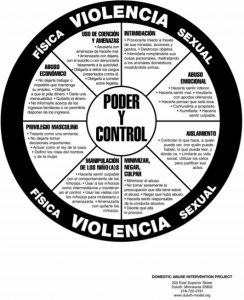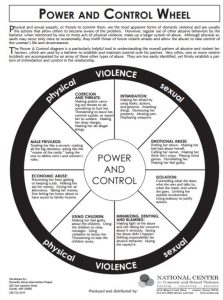What Is Abuse

Understand how an abuser may behave.
The Power & Control diagram can help you understand the overall pattern of behaviors an abuser may use to get and keep control over a partner. Very often, an abuser will use many types of abuse in addition to violence.
Kinds of Abuse
What is domestic violence?
What is sexual assault?
What is physical abuse?
What is emotional abuse?
What is economic abuse?
While this information uses the example of a man as the abuser, a woman can be the abuser.
What is domestic violence?
 Domestic violence is when one partner in an intimate relationship abuses the other. It involves a pattern of abuse to get and keep power and control.
Domestic violence is when one partner in an intimate relationship abuses the other. It involves a pattern of abuse to get and keep power and control.
- Abuse can be physical, sexual, emotional, and/or economic or a mix of these.
- Abuse can happen even without physical violence. Abusers may control you through intimidation, threats, psychological abuse, and isolation, or they control your access to money.
- Abuse can happen to anyone. It does not matter where you live, how much money you have, what language you speak, how old you are, whether you are male, female or transgender, gay, lesbian or straight.
- Abusers feel entitled to control how their victims think, feel, and act.
- Fear drives an abusive relationship. To stay safe, one party tries to do what the other wants.
If you are experiencing domestic violence, you are not alone.
- On average, nearly 20 people per minute are physically abused by an intimate partner in the United States. That’s more than 10 million women and men each year.
- On a typical day, domestic violence hotlines nationwide get more than 20,000 phone calls.
- One in 3 women and 1 in 4 men have been victims of physical violence by an intimate partner within their lifetime.
- Intimate partner violence accounts for 15% of all violent crime.
- Women between the ages of 18-24 are most commonly abused by an intimate partner.
- Domestic victimization is correlated with a higher rate of depression and suicidal behavior.
(Source: National Coalition Against Domestic Violence)
Learn more about domestic violence.
Back to top.
What is sexual assault?
Sexual assault is any unwanted sexual experience. It means sexual contact or behavior that occurs without the victim’s explicit consent, usually through force or manipulation.
- It can be physical violence, verbal sexual harassment, or both.
- Sexual desire does NOT cause someone to want to force sex upon another person. Sex without consent is an act of violence and power, not sex.
- Sexual violence is about using sexual acts to control, humiliate, and harm another person.
- Unwanted touching is considered sexual assault.
- Forcing a victim to perform a sexual act is also sexual assault.
- Sexual assault can happen to children and to men and between intimate partners.
- Rape means penetrating the victim’s body without consent. Rape is a form of assault that can happen in any relationship, including with your spouse, partner, date, or acquaintance.
- Attempted rape is also considered sexual violence.
Other forms of sexual violence include
- Incest, or sexual abuse among family members.
- Ritual abuse, an extreme, sadistic form of abuse of children and non-consenting adults.
- Showing one’s genitals or naked body to another without consent.
- Voyeurism, or watching someone in a private act without their knowledge or permission.
Sexual assault happens all too often.
- Every 98 seconds, an American is sexually assaulted.
- One out of every six American women has been the victim of an attempted or completed rape in her lifetime.
- Seven out of 10 rapes are committed by someone the victim knows.
- On average, there are 321,500 victims (age 12 or older) of rape and sexual assault each year in the United States.
- Nine out of every 10 rape victims are female.
- Of women who are raped, 33 percent contemplate suicide, and 94 percent experience post-traumatic stress disorder (PTSD) in during the two weeks after the rape.
- Approximately 70 percent of rape or sexual assault victims experience moderate to severe distress, a larger percentage than for any other violent crime.
(Source: RAINN)
Learn more about sexual violence.
Back to top.
What is physical abuse?
Physical abuse is any intentional and unwanted contact. It does not have to cause pain or leave a bruise to be unhealthy.
- Physical abuse includes scratching, punching, biting, strangling or kicking.
- Throwing things at you and pushing or pulling you can be abuse.
- If someone grabs your clothing or face or pulls your hair, that is physical abuse.
- Abuse also includes smacking your bottom without permission.
If you feel you are in immediate physical danger, call 911. If you’d like help navigating a difficult relationship, call us at 719-486-3530. To learn more, check out these resources.
Back to top.
What is emotional abuse?
In emotional and psychological abuse, the abuser tries to control the victim’s mind.
- It includes name calling and constant criticism.
- The abuser may deny the abuse happened or minimize its importance, saying you are too sensitive.
- An abuser may blame you for anything that happens to him or her and may even say the abuse is your fault.
- Threats to hurt you, your children, other family members, or your pets are emotional abuse.
- The abuser may be jealous and possessive. He may try to isolate you from friends and family and monitor where you are.
- He may try to control your appearance: your clothes, hairstyle, etc.
- The abuser may gaslight you, or try to make you doubt your own mind by telling you things didn’t happen as you know they did.
What is economic abuse?
Economic or financial abuse is when a partner tries to control your access to money. Financial abuse is part of 98% of abusive relationships. (Source: National Network to End Domestic Violence)
- Controlling money is very effective at keeping a victim trapped in the relationship. Victims are afraid to leave or may go back to an abuser, because they fear they cannot pay for their needs or their children’s.
- The abuser may cut off your access to bank accounts, try to account for every penny spent, or limit you to an allowance.
- He may hide information about the family’s finances.
- An abuser may try to keep you from working or harass you at work so that you lose your job.
- He may run up debt on joint accounts or stop paying bills.
- He may refuse to give you money for basic needs such as food and medicine, which is financial abuse.
- The abuser may not pay child support. He may force the victim to turn over money she receives for public benefits or may threaten to report her to the authorities for misusing benefits.

